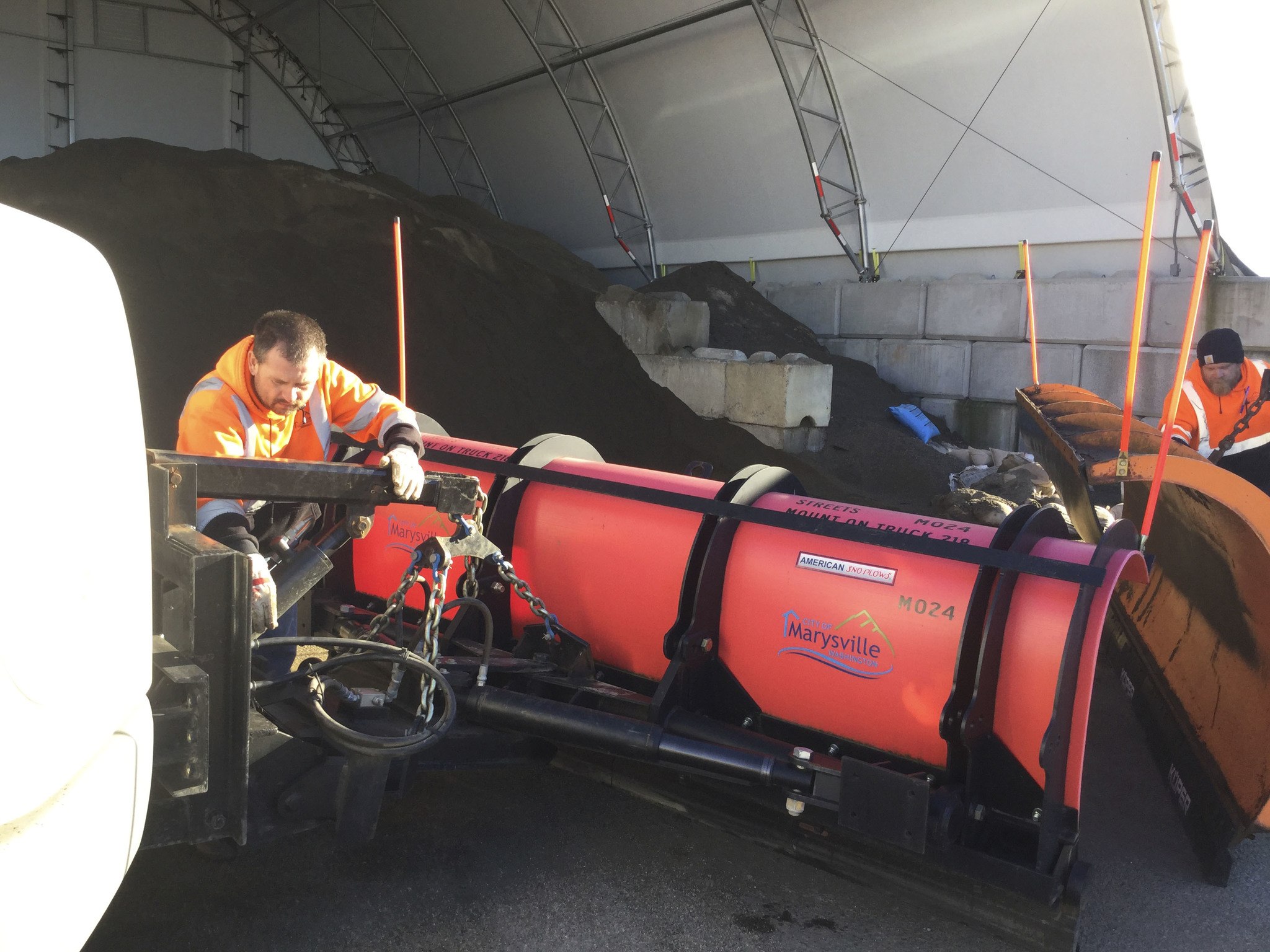’Twas the white before Christmas, and all through the town,
Few creatures were stirring, many wore a frown,
Snow causes crazy traffic throughout Puget Sound,
No worries, rain will make sure, it doesn’t stick around.
The first snowfall of the season hit Arlington and Marysville Thursday night.
Marysville schools were canceled, and Lakewood and Arlington were two hours late. Most main roads were clear, but some of the roads less traveled were slick with packed snow.
The National Weather Service has forecasted a winter storm over Western Washington packing 1-3 inches of snow for the Arlington and Marysville areas with temperatures dropping into the mid-20s overnight, turning to rain Friday.
Forecasters said next week could bring more scattered snow showers.
Public works crews in Marysville and Arlington were well-prepared for snow and icy conditions on local roads.
“Bring it on,” Marysville public works director Kevin Nielsen said. “We’re all over it.”
“We’re in really good shape this year,” agreed Leroy Mills, Arlington Public Works maintenance and operations manager. “We’ve been well-prepared for over a month.”
The big storm that never materialized last month was a perfect emergency preparedness dress rehearsal for public works and first-responder crews and resources.
Marysville
Marysville public works crews mobilized at the first sign of snow and dropping temperatures Thursday.
Safety on local roads is a top priority, and keeping traffic moving throughout Marysville as efficiently as possible, Nielsen said.
Marysville dispatched a fleet that includes several vehicles equipped for snow and ice control, including three 10-yard trucks for plowing and sanding and another 10-yard truck that sands; 2 five-yard trucks, a 1-ton truck for plowing and sanding, and another that dispenses anti-icing liquid, Nielsen said. The fleet also added a new dump truck and sander, and a second vehicle to dispense anti-icing material.
In keeping with the city’s snow and ice response plan, crews focused on principal routes and arterials that included State, 51st, 67th, 83rd and Twin Lakes avenues; 4th, Grove, 88th 116th and 136th and 152nd and 172nd west of I-5 in the Lakewood area; and Sunnyside, Ingraham and Smokey Point boulevards.
Crews closed the steep 84th Street past Cedarcrest Golf Course, and put up “Snow Closure-Do Not Enter” signs and barricades.
The city’s snow and ice removal plan designates snow and ice routes for sanding and plowing using a zoned system, Nielsen said.
Within each zone, a system of priority has been established, taking into consideration topography, traffic volumes and special usage.
During events where snow and ice are widespread, street personnel concentrate removal efforts on arterials leading in and out of the city, roads located on hills within the city, fire and police access, and all other arterials within the city as time and resources permit.
The street department maintains 196 miles of streets. Street crews provide round-the-clock coverage in multi-shifts.
The public works yard is amply stockpiled with sand and de-icer, with a proportion of the materials relocated to a new north satellite storage area near 156th Street to provide quicker response to Marysville’s north end and Lakewood neighborhoods.
When notified of black ice alerts, public works schedules a two-person crew to start no later than midnight to apply the de-icing mix to bridge decks, overpasses and other problem areas.
Arlington
Arlington public works sent two 1-ton plow and sand trucks to clear the Arlington Municipal Airport and runways Dec. 8, then redirected them to assist four other 1-ton plow trucks take care of other areas of the city, the cemetery, public facility parking lots and neighborhood cul de sacs, Mills said.
Arlington dispatched its 10-ton plow trucks to first tackle busiest primary routes that feed into state-maintained highways including State Routes 530, 531 and Highway 9, Mills said. Roads such as 67th and 59th avenues, 211th Place, 188th Street and Airport Boulevard are often used by public safety vehicles, transit agencies, hospitals and schools.
The department uses a sand-and-salt mixture and de-icing materials to make local roads as ice- and snow-free as possible.
Mills said crews on 12-hour shifts also focused on streets that connect neighborhoods, then residential streets, in accordance with the city’s snow and ice removal plan when time and resources allow.
Although snow and ice don’t typically force full closure of any hilly routes, Burn Road is one stubborn route that needs extra attention, Mills said. The largely shaded two miles see no sun.
The city sweeps and reuses the sand-and-salt mixture it uses, recycling as much as 40 percent, which saves on material costs.
Mills reminded folks that if motorists are behind city plows, don’t crowd them. Use caution and give workers plenty of room – about 200 feet – to clear the roads, especially on steep hills.
“We want people to be as safe as possible when they’re out on the roads, and we want our crews to be, too,” Mills said. “Most drivers are pretty good about cooperating.”
Mills offered preparation advice, recommending that people keep an emergency preparedness kit in their trunk, which should at a minimum include extra food and bottled water, flashlights and batteries, blankets, a first aid kit, candles, and matches or a lighter, and a car phone charger.
Although it didn’t arrive soon enough for this snowfall, the city will be getting a third 1 ton plow and sander truck in a few weeks.
Mills said public works manages 191 lane miles.
When ice and snow are severe enough, public works can also press extra loaders and graders into action.
The public works yard stockpiles a minimum of 125 yards of salt and 400 yards of sand, Mills said.



